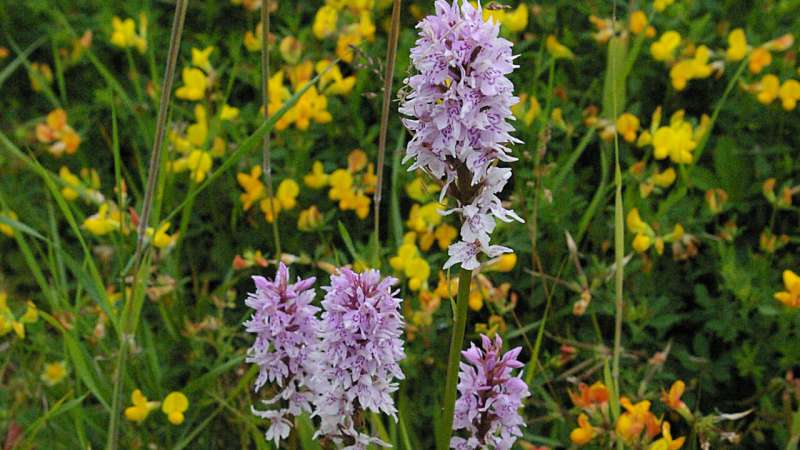This article has been reviewed according to Science X's editorial process and policies. Editors have highlighted the following attributes while ensuring the content's credibility:
fact-checked
peer-reviewed publication
trusted source
proofread
Orchid plants nurture their seedlings via shared underground fungal network, study shows

The Common Spotted Orchid (Dactylorhiza fuchsii) is found all over the U.K. These orchids produce tiny seeds that can be carried anywhere by the wind, yet they often appear in clumps with small seedlings growing near mature plants. This phenomenon has puzzled ecologists since Darwin's time, with the exact reason remaining a mystery.
A new study, led by researchers from the University of Sheffield in collaboration with The University of Manchester, provides the first evidence that early stage orchid seedlings germinate and thrive near to adult plants due to a kind of parental nurture using underground fungal networks.
Scientists investigated the idea that fungal networks, known as mycorrhizal networks, act as a direct pathway for established orchid plants to share recently produced sugars with developing seedlings.
Professor Katie Field, co-author of the study and Professor of Plant-Soil Processes at the University of Sheffield's School of Biosciences, said, "Our results support the idea that some orchids engage in a form of 'parental nurture' with their seedlings.
"By supplying early stage seedlings with essential nutrients via shared fungal connections, the parent orchids give the seedlings an advantage over neighboring plants that are competing for the same resources.
"This finding is exciting because why these orchids are often found in clumps, despite their seeds being wind dispersed, has been a puzzle for hundreds of years."
The study focused on the Common Spotted Orchid and its fungal partner, Ceratobasidium cornigerum. Researchers created a system where mature, green orchids were connected to developing, chlorophyll-free seedlings through a fungal network grown on agar.
The mature plants were then exposed to a special form of carbon dioxide that could be tracked within the system.
Here's how it worked:
- Green orchid plants were connected to developing seedlings through the fungal network.
- The green plants were then exposed to a special form of carbon dioxide that could be tracked within the system.
- After a period of time, the researchers analyzed both the seedlings and the fungal network to see where the labeled carbon ended up.
The results were clear, the seedlings were accumulating the labeled carbon, indicating they were being supported by the adult plants. By tracking the movement of carbon, the study showed that the mature orchids were indeed sharing their recently produced sugars with the seedlings through the fungal network.
Sir David Read, Emeritus Professor of Plant Sciences from the University of Sheffield and lead author of the study, said, "Whereas the seeds of most plants, for example legumes (peas, beans) and grasses (rice, corn, wheat) are fully provisioned with food reserves by their parent plants, the so-called dust seeds of orchids receive insufficient reserves from the parents to develop on their own.
"They are instead produced in their millions by each individual parent orchid plant from which they are dispersed, by wind, to the surrounding environment. Even Charles Darwin was puzzled by this strategy, suggesting that while it should enable the seeds of an individual orchid plant to be so widely distributed that within a few years it could colonize the whole world. He observed that their failure to do so 'could not be understood at this time.'
"What is now revealed is that the belowground development of these essentially reserve-free seeds can be supported by photosynthetically produced sugars that are transported to them from mature plants growing above ground through a shared mycelium of symbiotic fungi."
Results of the study, published in New Phytologist, show the amount of carbon transferred seemed to depend on the environment. When the fungus had access to a richer food source (oatmeal agar), less carbon was transferred to the seedling. This suggests that the strength of the demand from the seedlings may influence the flow of nutrients through the network.
This research has important implications for understanding orchid ecology and conservation efforts. By recognizing the importance of fungal connections, scientists can develop better strategies for protecting these unique and often threatened plants.
Next steps are to research this theory in the natural habitat that the orchids are found in and to look at whether this applies to other species.
More information: David J. Read et al, Photosynthate transfer from an autotrophic orchid to conspecific heterotrophic protocorms through a common mycorrhizal network, New Phytologist (2024). DOI: 10.1111/nph.19810
Journal information: New Phytologist
Provided by University of Sheffield




















